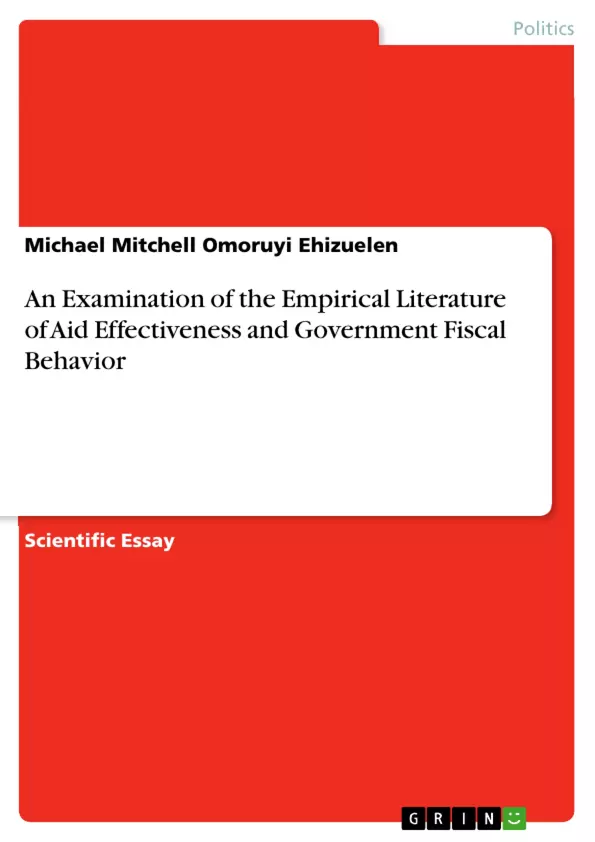The issue behind the effectiveness of external finance has been studied from diverse perspectives. The question of whether external finance assists poor nations to develop in a sustained manner is still mired in controversy. Development assistance may be given to governments; but the effectiveness will crucially rely on their fiscal response. The relationship between the fiscal activities of the government and foreign aid is however, not straight forward, for the reason that some part of the development assistance is fungible. The preponderance proof from empirical literature on the effectiveness of aid proposes that external finance has not had a noteworthy influence on growth in most receiving nations. However, there are some proofs that external finance has had some significant impacts on development in most conducive policy climates. Most of the evidence concerning the correlation between aid and the key channels via which its influence on growth could flow on domestic saving and investment is mixed. This is because some indication shows that aid has had significant influence on investment and domestic saving in nations where adjustment efforts have been sustained.
Inhaltsverzeichnis (Table of Contents)
- Introduction
- Literature Review of Aid Effectiveness and their Fiscal Responses
- The Impact of Aid on Growth
- The Impact of Aid on Domestic Savings and Investment
- The Impact of Aid on Government Expenditure
- Donor-Recipient Relationships and the Influence of Political Regimes
- The “Dutch Disease” Effect of Aid
- Conclusion
Zielsetzung und Themenschwerpunkte (Objectives and Key Themes)
This paper investigates the relationship between external finance and economic growth in developing countries, focusing on the effectiveness of aid and the fiscal responses of recipient governments. The main objectives are to examine the empirical literature on the impact of development assistance on poverty alleviation and economic growth, and to understand the influence of government behavior on aid effectiveness. Key themes include:- The debate on aid effectiveness and the various perspectives on its impact on growth.
- The influence of government fiscal policies on the allocation and utilization of aid.
- The role of domestic savings and investment in achieving sustainable development with aid.
- The potential for aid to lead to "Dutch disease" effects, impacting export competitiveness.
- The importance of donor-recipient relationships and political regimes in influencing aid effectiveness.
Zusammenfassung der Kapitel (Chapter Summaries)
Introduction
This section provides an overview of the long-standing debate surrounding the effectiveness of foreign aid and the role it plays in promoting sustainable development in poor nations. It highlights the controversy regarding whether aid can truly assist developing countries in achieving sustained economic growth, despite the vast sums of money that have been allocated over the decades.Literature Review of Aid Effectiveness and their Fiscal Responses
This chapter presents a comprehensive review of the existing literature on aid effectiveness and its impact on government fiscal behavior. It explores various theoretical models and empirical studies that have attempted to understand the relationship between aid, government expenditure, and economic growth. The review delves into key concepts such as aid fungibility and the influence of government policy decisions on the effectiveness of aid.The Impact of Aid on Growth
This section examines the various perspectives and models that have been proposed to understand the potential role of aid in promoting economic growth. It discusses the "two-gap models" theory, which suggests that constraints on domestic savings and foreign exchange earnings hinder investment in developing countries. The chapter explores whether aid can effectively bridge these gaps and stimulate growth.The Impact of Aid on Domestic Savings and Investment
This section analyzes the empirical evidence regarding the influence of aid on domestic savings and investment in recipient countries. It discusses the mixed findings from various studies, highlighting cases where aid has had a positive impact on investment and savings, particularly in countries with sustained adjustment efforts.The Impact of Aid on Government Expenditure
This chapter delves into the complex relationship between aid and government expenditure, examining how aid influences the allocation of resources between consumption and investment. It explores the potential for aid to crowd out private sector investment and the importance of government policy in mitigating this effect.Donor-Recipient Relationships and the Influence of Political Regimes
This section discusses the crucial role of donor-recipient relationships and the nature of political regimes in influencing aid effectiveness. It examines how incentives within the donor-recipient association can shape recipient government policies, potentially leading to aid reliance and undermining growth.The “Dutch Disease” Effect of Aid
This section explores the potential negative effects of aid on export competitiveness, known as the "Dutch disease." It investigates how aid can lead to an appreciation of the real exchange rate, making exports less competitive in the global market. The chapter discusses government policy options for mitigating this effect and promoting sustainable development.Schlüsselwörter (Keywords)
The main keywords and focus topics of this paper are: aid effectiveness, fiscal response, government expenditure, growth, savings, investment, Dutch disease, donor-recipient relationships, political regimes, development assistance, official development assistance (ODA), fungibility, and poverty alleviation. These terms encapsulate the core concepts and themes explored in the text, offering insights into the complex relationship between external finance and economic growth in developing countries.- Quote paper
- Michael Mitchell Omoruyi Ehizuelen (Author), 2010, An Examination of the Empirical Literature of Aid Effectiveness and Government Fiscal Behavior, Munich, GRIN Verlag, https://www.grin.com/document/266780



